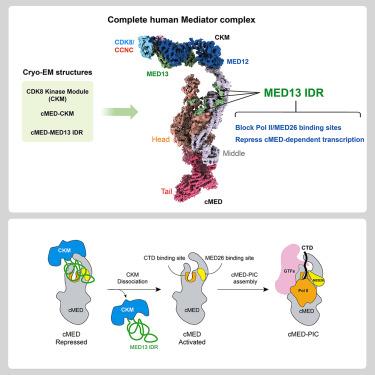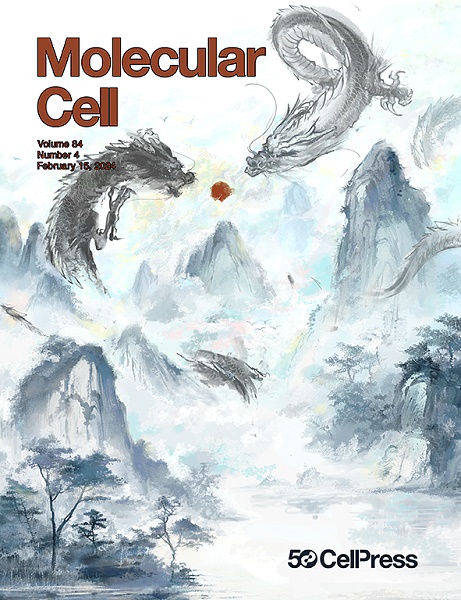Structural basis of the human transcriptional Mediator regulated by its dissociable kinase module
IF 14.5
1区 生物学
Q1 BIOCHEMISTRY & MOLECULAR BIOLOGY
引用次数: 0
Abstract
The eukaryotic transcriptional Mediator comprises a large core (cMED) and a dissociable CDK8 kinase module (CKM). cMED recruits RNA polymerase II (RNA Pol II) and promotes pre-initiation complex formation in a manner repressed by the CKM through mechanisms presently unknown. Herein, we report cryoelectron microscopy structures of the complete human Mediator and its CKM. The CKM binds to multiple regions on cMED through both MED12 and MED13, including a large intrinsically disordered region (IDR) in the latter. MED12 and MED13 together anchor the CKM to the cMED hook, positioning CDK8 downstream and proximal to the transcription start site. Notably, the MED13 IDR obstructs the recruitment of RNA Pol II/MED26 onto cMED by direct occlusion of their respective binding sites, leading to functional repression of cMED-dependent transcription. Combined with biochemical and functional analyses, these structures provide a conserved mechanistic framework to explain the basis for CKM-mediated repression of cMED function.

由可分离激酶模块调控的人类转录媒介的结构基础
真核生物转录介导子由一个大核心(cMED)和一个可分离的 CDK8 激酶模块(CKM)组成。cMED 通过目前尚不清楚的机制招募 RNA 聚合酶 II(RNA Pol II),并以被 CKM 抑制的方式促进预启动复合物的形成。在此,我们报告了完整的人类 Mediator 及其 CKM 的冷冻电镜结构。CKM 通过 MED12 和 MED13 与 cMED 上的多个区域结合,包括后者的一个大的内在无序区 (IDR)。MED12 和 MED13 共同将 CKM 固定在 cMED 钩子上,使 CDK8 位于转录起始位点的下游和近端。值得注意的是,MED13 IDR 通过直接阻塞 RNA Pol II/MED26 与 cMED 的结合位点,阻碍了它们在 cMED 上的招募,从而导致 cMED 依赖性转录的功能抑制。结合生化和功能分析,这些结构为解释 CKM 介导的 cMED 功能抑制提供了一个保守的机制框架。
本文章由计算机程序翻译,如有差异,请以英文原文为准。
求助全文
约1分钟内获得全文
求助全文
来源期刊

Molecular Cell
生物-生化与分子生物学
CiteScore
26.00
自引率
3.80%
发文量
389
审稿时长
1 months
期刊介绍:
Molecular Cell is a companion to Cell, the leading journal of biology and the highest-impact journal in the world. Launched in December 1997 and published monthly. Molecular Cell is dedicated to publishing cutting-edge research in molecular biology, focusing on fundamental cellular processes. The journal encompasses a wide range of topics, including DNA replication, recombination, and repair; Chromatin biology and genome organization; Transcription; RNA processing and decay; Non-coding RNA function; Translation; Protein folding, modification, and quality control; Signal transduction pathways; Cell cycle and checkpoints; Cell death; Autophagy; Metabolism.
 求助内容:
求助内容: 应助结果提醒方式:
应助结果提醒方式:


